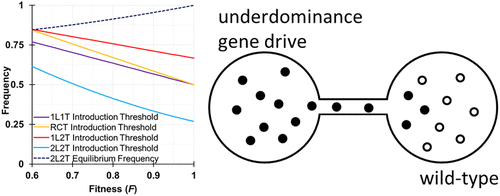当前位置:
X-MOL 学术
›
ACS Synth. Biol.
›
论文详情
Our official English website, www.x-mol.net, welcomes your
feedback! (Note: you will need to create a separate account there.)
Population Dynamics of Underdominance Gene Drive Systems in Continuous Space.
ACS Synthetic Biology ( IF 3.7 ) Pub Date : 2020-03-06 , DOI: 10.1021/acssynbio.9b00452 Jackson Champer , Joanna Zhao , Samuel E. Champer , Jingxian Liu , Philipp W. Messer
ACS Synthetic Biology ( IF 3.7 ) Pub Date : 2020-03-06 , DOI: 10.1021/acssynbio.9b00452 Jackson Champer , Joanna Zhao , Samuel E. Champer , Jingxian Liu , Philipp W. Messer

|
Underdominance systems can quickly spread through a population, but only when introduced in considerable numbers. This promises a gene drive mechanism that is less invasive than homing drives, potentially enabling new approaches in the fight against vector-borne diseases. If regional confinement can indeed be achieved, the decision-making process for a release would likely be much simpler compared to other, more invasive types of drives. The capacity of underdominance gene drive systems to spread in a target population without invading other populations is typically assessed via network models of panmictic demes linked by migration. However, it remains less clear how such systems would behave in more realistic population models where organisms move over a continuous landscape. Here, we use individual-based simulations to study the dynamics of several proposed underdominance systems in continuous-space. We find that all these systems can fail to persist in such environments, even after an initially successful establishment in the release area, confirming previous theoretical results from diffusion theory. At the same time, we find that a two-locus two-toxin-antidote system can invade connected demes through a narrow migration corridor. This suggests that the parameter space where underdominance systems can establish and persist in a release area while at the same time remaining confined to that area could be quite limited, depending on how a population is spatially structured. Overall, these results indicate that realistic spatial context must be considered when assessing strategies for the deployment of underdominance drives.
中文翻译:

连续空间中显性基因驱动系统的种群动态。
自治系统可以迅速地在整个人群中传播,但是只有在引入大量系统之后才可以。这有望提供一种基因驱动机制,其归巢驱动力比归巢驱动器具有更低的侵入性,从而有可能为对抗媒介传播疾病提供新方法。如果确实可以实现区域限制,则与其他更具侵入性的驱动器相比,发布的决策过程可能会简单得多。显性基因驱动系统在目标种群中传播而不会侵袭其他种群的能力通常是通过与迁徙相关联的恐慌事件的网络模型来评估的。但是,尚不清楚这种系统在生物体在连续景观上移动的更现实的种群模型中的行为方式。这里,我们使用基于个体的模拟研究连续空间中几个拟议的支配性系统的动力学。我们发现,即使在释放区最初成功建立之后,所有这些系统也可能无法在这样的环境中持续存在,从而证实了扩散理论的先前理论结果。同时,我们发现,两位两毒解毒剂系统可以通过狭窄的迁移走廊入侵相连的动物。这表明控制系统可以在释放区域建立并持续存在,而同时又局限于该区域的参数空间可能非常有限,这取决于总体的空间结构。总的来说,这些结果表明,在评估主导地位驱动器的部署策略时,必须考虑现实的空间环境。
更新日期:2020-04-23
中文翻译:

连续空间中显性基因驱动系统的种群动态。
自治系统可以迅速地在整个人群中传播,但是只有在引入大量系统之后才可以。这有望提供一种基因驱动机制,其归巢驱动力比归巢驱动器具有更低的侵入性,从而有可能为对抗媒介传播疾病提供新方法。如果确实可以实现区域限制,则与其他更具侵入性的驱动器相比,发布的决策过程可能会简单得多。显性基因驱动系统在目标种群中传播而不会侵袭其他种群的能力通常是通过与迁徙相关联的恐慌事件的网络模型来评估的。但是,尚不清楚这种系统在生物体在连续景观上移动的更现实的种群模型中的行为方式。这里,我们使用基于个体的模拟研究连续空间中几个拟议的支配性系统的动力学。我们发现,即使在释放区最初成功建立之后,所有这些系统也可能无法在这样的环境中持续存在,从而证实了扩散理论的先前理论结果。同时,我们发现,两位两毒解毒剂系统可以通过狭窄的迁移走廊入侵相连的动物。这表明控制系统可以在释放区域建立并持续存在,而同时又局限于该区域的参数空间可能非常有限,这取决于总体的空间结构。总的来说,这些结果表明,在评估主导地位驱动器的部署策略时,必须考虑现实的空间环境。











































 京公网安备 11010802027423号
京公网安备 11010802027423号